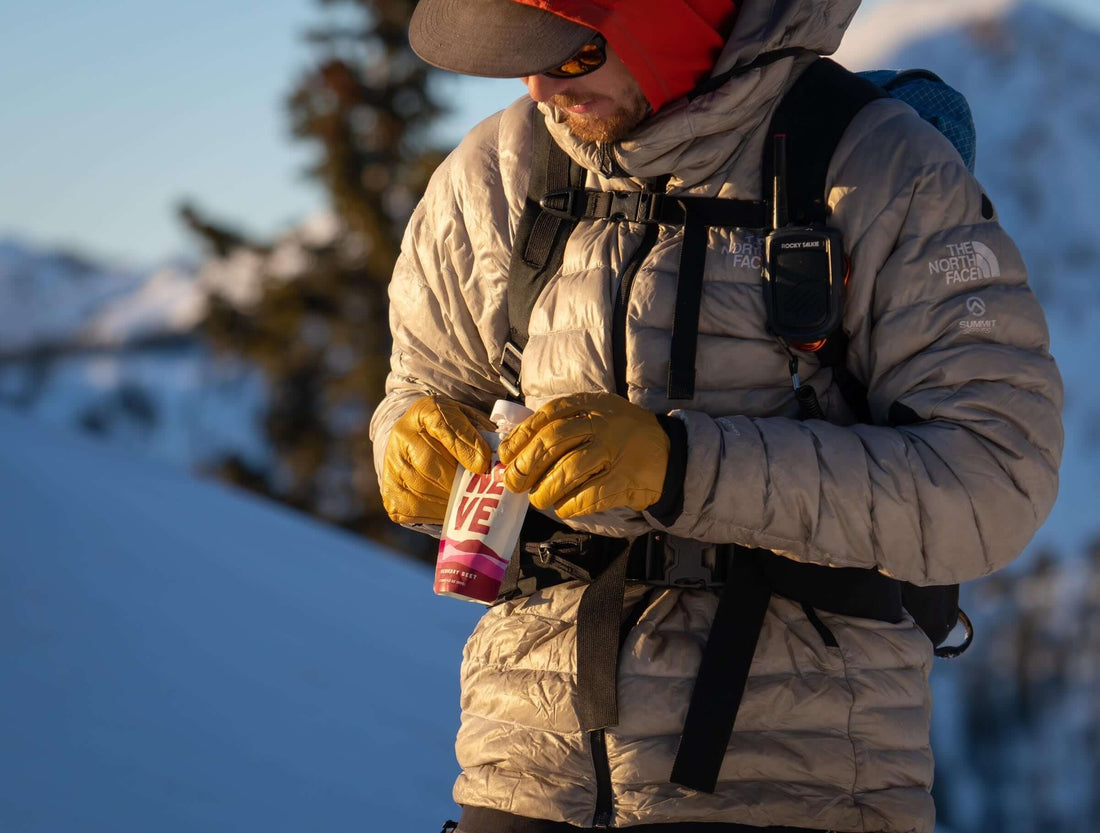
Backcountry Skiing Is Near: Fuel with the Best Ski Snacks
Nora FiermanBackcountry days are special, but they demand more from your body. When you're skinning up, breaking trail, carrying gear, and then skiing down, your fuel needs are intense. Choosing the best snacks for ski trips, particularly good ski snacks that survive cold, can make all the difference.
Here’s how to fuel smart in the backcountry. What to bring, when to eat, and why Neve is one of the best options out there for snacks to take skiing that actually work.
Why Backcountry Skiing Changes the Snack Game
- Higher energy burn: Backcountry ski touring can burn 400–700+ calories per hour, depending on steepness, snow conditions, weight, fitness.
- Cold & altitude challenges: Cold weather slows digestion, cold fingers and freeze of food/items makes eating hard. Altitude increases fluid loss and thirst can be dulled.
- Need consistency: Experts suggest eating “quick, easily digestible carbs every 30–60 minutes during activities longer than 90 minutes” to maintain energy and cognitive sharpness.
What to Bring: Best Ski Snacks for Backcountry Days
When picking high energy snacks for skiing, you want items that are calorie-rich, easy to eat, and resistant to cold. For long tours, here are some options:
Snack Examples |
Nora's Notes |
| Cheez-Its or Cheddar Bunnies | Salty snacks are great as a change up for traditionally sweet snacks. I love to pair Cheez-Its with Boysenberry Beet Neve for a backcountry charcuterie experience. |
| Rice Crispy Treats or gummies | Fast energy, easy to digest uphill when appetite lags. |
| Dinner leftovers | Literally I am not kidding. Pasta? Made for a bag. Burrito? Easy. Food is more portable than you think! |
| Warm fluids or hot teas with honey | Comfort + carbs + hydration; helps counter cold |
| Literally any baked good | Bakes goods are simple carbs that taste good! If you are excited to eat your fuel, you will fuel! |
| Neve! | Of course, I need to mention Neve. I love pairing Neve with other forms of fuel. Pro tip: keep close to your body if it's cold out! |
When to Fuel
- Pre-tour breakfast: Fill up with high-carb, moderate protein, low-fat meal 1–2 hours before starting. Think oats, non-dairy milk, fruit, maybe nut butter if you tolerate it.
- On the ascent: Aim to eat something every 30-60 minutes. Even if you don’t feel hungry, it helps avoid “bonk.” Small, frequent fuel works better than waiting for hunger.
- During long breaks or summit time: When you're resting, it’s a good opportunity for something with more substance. Maybe a wrap, sandwich, or a pouch where you can sit, warm hands, and enjoy.
- Post-tour recovery: Within 30–60 minutes after finishing, aim for a snack or small meal combining carbs + protein to replenish glycogen and support muscle repair. Renew hydration, electrolytes.
Cold-Weather Snack Survival Tips
- Keep snacks close to your body (internal pockets, chest) so they don’t freeze.
- Use pouches / squeezable foods which are more resilient in cold vs rigid bars which freeze solid. Did someone say Neve?!
- Insulated flasks or containers for hot fluids. Warm liquids help both energy and body temperature.
- Try items in training days first. See what works when cold, hungry, gloves on/off, etc.
Where Neve Fits In: Backcountry Skier’s Fuel
Neve’s smoothie pouches are especially helpful on backcountry ski days for several reasons:
- Portable & resealable pouch design survives cold better than some bars. If it's really cold, keep close to your body.
- Provides a clean source of carbohydrates + functional ingredients to support sustained energy and recovery. Because backcountry skiing is slower movement, you can handle more fat, so Neve is the perfect friend!
- Designed with input from a Registered Dietitian so the ingredients are intentional. The goal isn’t just calories, but fuel that works when your body is under cold, physical stress.
- Fuel on your own terms. You can take in small squeezes throughout ascent, or use as bigger bites during rest or descent. Great when appetite fluctuates.
Sample Backcountry Ski Fuel Pack
Here’s what a fuel plan might look like for a full backcountry ski tour (~6-8 hours):
- Pre-dawn: warm oatmeal + fruit + Neve pouch
- Ascent (hours 1-3): Crackers + Neve pouch + water with electrolytes every 30-60 min
- Summit break: sandwich or wrap + maybe a hot tea + Neve pouch
- Descent: small snacks (energy chew), hydrate more
- Post return: recovery snack with carbs + protein (Tart Cherry Cacao Neve recovery pouch works well), warm meal with veggies + protein source
Final Thought
For backcountry skiing, snacks aren’t just backups, they’re mission critical. The cold, altitude, time on feet, and elevation gain all conspire to sap energy fast. Letting fuel lag behind is what turns epic days into disasters. No one really likes to be with that bonked friend. Do us all a favor, grab some Neve.

